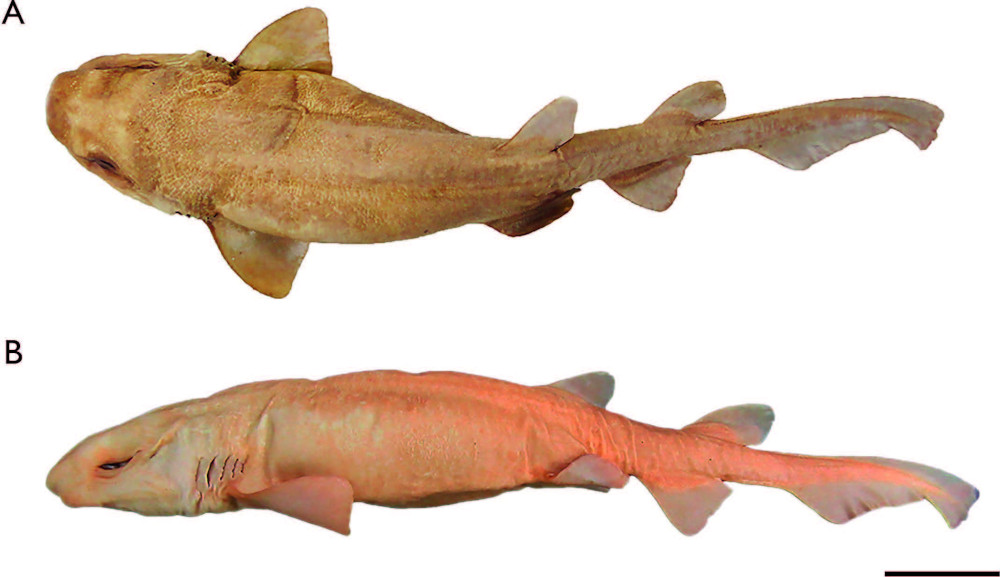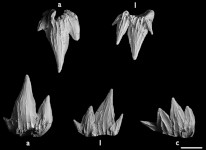Parmaturus angelae
Soares, De Carvalho, Schwingel & Gadig, 2019
Brazilian Filetail Catshark
Classification: Elasmobranchii Carcharhiniformes Pentanchidae
Reference of the original description
A New Species of Parmaturus (Chondrichthyes: Carcharhiniformes: Scyliorhinidae) from Brazil, Southwestern Atlantic. Copeia, 107(2), 314–322
A New Species of Parmaturus (Chondrichthyes: Carcharhiniformes: Scyliorhinidae) from Brazil, Southwestern Atlantic. Copeia, 107(2), 314–322
Description :
Citation: Parmaturus angelae Soares, De Carvalho, Schwingel & Gadig, 2019: In: Database of modern sharks, rays and chimaeras, www.shark-references.com, World Wide Web electronic publication, Version 12/2025
Please send your images of "Parmaturus angelae" to info@shark-references.com

Parmaturus angelae Soares, De Carvalho, Schwingel & Gadig, 2019, holotype, MZUSP 124000, female, 398 mm TL. (A) Dorsal view, (B) lateral view. Scale bar 25 mm. © Karla A. Soares, Laboratório de Ictiologia, Departamento de Zoologia, Instituto de Biociências, Universidade de São Paulo

Parmaturus angelae Soares, De Carvalho, Schwingel & Gadig, 2019, holotype, MZUSP 124000, female, 398 mm TL. (A) Dorsal view, (B) lateral view. Scale bar 25 mm. © Karla A. Soares, Laboratório de Ictiologia, Departamento de Zoologia, Instituto de Biociências, Universidade de São Paulo
Common names
 Brazilian Filetail Catshark,
Brazilian Filetail Catshark,  Angela’s Catshark
Angela’s Catshark
 Brazilian Filetail Catshark,
Brazilian Filetail Catshark,  Angela’s Catshark
Angela’s Catshark
Short Description
Original Diagnosis after SOARES, DE CARVALHO, SCHWINGEL & GADIG, 2019 [27304]: A southwestern Atlantic species of Parmaturus distinguished from its congeners by the following combination of characters: first dorsal-fin origin slightly anterior to pelvic-fin origin (vs. well anterior in P. campechiensis); dorsal fins subequal (vs. first dorsal fin smaller in P. campechiensis and first dorsal fin slightly larger in P. xaniurus); upper caudal crest of denticles separated from lateral denticles by naked strip (vs. barely separated in P. xaniurus); lower caudal crest of denticles well developed and extending until last third of ventral caudal-fin lobe (vs. extending until the end of ventral caudal-fin lobe in P. campechiensis and reduced or absent in P. xaniurus); labial furrows discontinuous (vs. continuous in P. campechiensis and P. xaniurus); anal-fin base 1.6 times anal-fin height (vs. 3 times in P. campechiensis and 2.2–2.5 in P. xaniurus); pre-first dorsal-fin length 4.3 times interdorsal space (vs. 4.9 times in P. xaniurus); prenarial length 0.8–1.1 times in prepectoral length (vs. 0.3 times in P. campechiensis); mouth width 2.6 times mouth length (vs. 1.9 times in P. campechiensis); monospondylous precaudal centra 38 (vs. 39 in P. campechiensis), and total vertebrae counts 121–122 (vs. 111 in P. campechiensis and 109–121 in P. xaniurus).
Original Diagnosis after SOARES, DE CARVALHO, SCHWINGEL & GADIG, 2019 [27304]: A southwestern Atlantic species of Parmaturus distinguished from its congeners by the following combination of characters: first dorsal-fin origin slightly anterior to pelvic-fin origin (vs. well anterior in P. campechiensis); dorsal fins subequal (vs. first dorsal fin smaller in P. campechiensis and first dorsal fin slightly larger in P. xaniurus); upper caudal crest of denticles separated from lateral denticles by naked strip (vs. barely separated in P. xaniurus); lower caudal crest of denticles well developed and extending until last third of ventral caudal-fin lobe (vs. extending until the end of ventral caudal-fin lobe in P. campechiensis and reduced or absent in P. xaniurus); labial furrows discontinuous (vs. continuous in P. campechiensis and P. xaniurus); anal-fin base 1.6 times anal-fin height (vs. 3 times in P. campechiensis and 2.2–2.5 in P. xaniurus); pre-first dorsal-fin length 4.3 times interdorsal space (vs. 4.9 times in P. xaniurus); prenarial length 0.8–1.1 times in prepectoral length (vs. 0.3 times in P. campechiensis); mouth width 2.6 times mouth length (vs. 1.9 times in P. campechiensis); monospondylous precaudal centra 38 (vs. 39 in P. campechiensis), and total vertebrae counts 121–122 (vs. 111 in P. campechiensis and 109–121 in P. xaniurus).
Dentition
Teeth small and numerous (Fig. 5), with two or more cusplets. Monognathic heterodonty weak; anterior teeth slightly larger with longer principal cusps than other teeth. Anterior teeth with one cusplet on each side, distal cusplet larger than the medial one. Lateral and commissural teeth with two well-developed cusplets on the medial border and one cusplet slightly smaller on the distal border. Longitudinal keels along the entire labial surface of the crown. Upper teeth slightly higher crowned than lower teeth. Teeth in 106/97 (102/94) rows, with 3/3 functional series. [27304]
Teeth small and numerous (Fig. 5), with two or more cusplets. Monognathic heterodonty weak; anterior teeth slightly larger with longer principal cusps than other teeth. Anterior teeth with one cusplet on each side, distal cusplet larger than the medial one. Lateral and commissural teeth with two well-developed cusplets on the medial border and one cusplet slightly smaller on the distal border. Longitudinal keels along the entire labial surface of the crown. Upper teeth slightly higher crowned than lower teeth. Teeth in 106/97 (102/94) rows, with 3/3 functional series. [27304]
Remarks
shark-references Species-ID=15454;
shark-references Species-ID=15454;



















